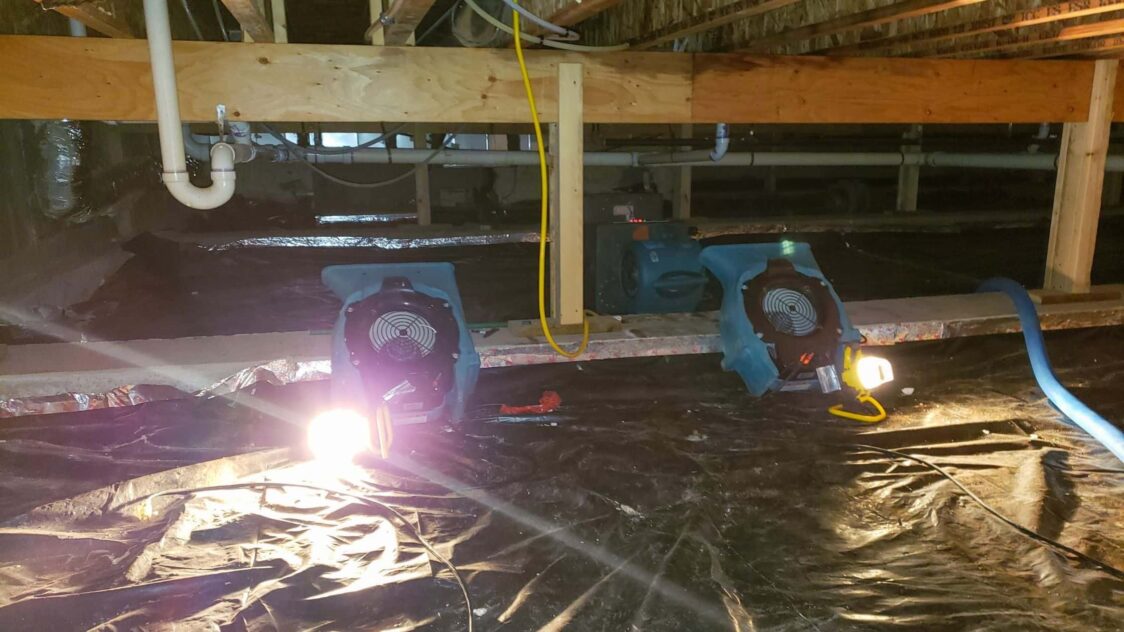
If you see water or moisture in your crawl space, you are searching for a way to dry it out! There are a myriad of reasons why your crawl space is wet. It could be from the condensation of your A/C unit, poor drainage, inadequate ventilation, or flooding from abundant rain in your area. No matter how your crawl space gets wet, it is an issue that should be dealt with promptly. Keeping your crawl space dry will keep various fungi and bacteria from growing in your home. This will protect it from wood rot and other structural problems.
Why is Your Crawl Space Wet?
Generally speaking, wet crawl spaces are caused by either an excess of moisture in the air or excess water in the soil near the home. Listed below are some of the main contributors that result in damp or wet conditions in your crawl space:
Foundation problems: If there are gaps or cracks in your foundation walls or the floor of the crawl space, water can potentially seep in.
Inadequate Ventilation: Airflow is important in a crawl space to prevent moisture buildup. Crawl spaces are notorious for having high humidity levels. If proper ventilation is not in place, condensation is very common. As warm moist air comes into contact with cooler surfaces within the crawl space, the air releases moisture and contributes to overall dampness in your crawl space.
Poor Drainage: Your home should have a drainage system that includes gutters and downspouts. This will direct water away from the foundation of your home. If this system is insufficient or malfunctioning, water can accumulate near the foundation. It will eventually find its way into your crawl space.
Flooding: Groundwater can cause problems for a crawl space in a number of ways. In areas with a high water table or poor soil drainage, groundwater can infiltrate through the foundation walls or floor. Heavy rains have become more common in our area over the last 60 years. After a heavy rain or rapid snow melt, the soil around the foundation of your home can become oversaturated. The water from the surrounding soil may push against the walls of the foundation. This can eventually find a way into your home.
Plumbing issues: Leaking or burst pipes can cause water to flow into the crawl space. Even if you have a vapor barrier in your crawl space, the water will sit on top of the liner until it evaporates.
How to Keep Your Crawl Space Dry?
Take these steps to remove water and moisture from your crawl space after water, storm flooding, or a sewer backup has entered the home.
- Clear the crawl space of any debris or wet material. This means any wet fiberglass or insulation that is there. After the debris is clear, you will want to check for any mold or fungus that could be growing. Mold and fungus thrive in dark and damp environments. So, a damp crawl space is a perfect place for these bacteria to grow.
- Along with clearing the debris, you will want to make sure you get rid of all standing water that is in the crawl space. The best way to get all the standing water out of your crawl space is by using a sump pump.
- Get the residual moisture out of the crawl space. The best way of getting the remaining moisture out is by using a dehumidifier. Using a dehumidifier will help dry out the air and take care of any remaining surface moisture that may be present.
- Contact a professional! Addressing the root problems of your wet crawl space will likely require a combination of preventative measures, drainage solutions, and waterproofing expertise.
More Info
It’s important to address a wet crawl space promptly to prevent further damage. If you are having trouble keeping your crawl space dry, there may be a larger issue with your home. Jerry’s Waterproofing has been keeping Nebraska and Iowa basements dry for more than 30 years. We have the experience and expertise to identify the source of your moisture problems and provide you with solutions, such as adding vapor barriers or crawl space encapsulation, to keep your crawl space dry.
Contact us today for a free estimate.



